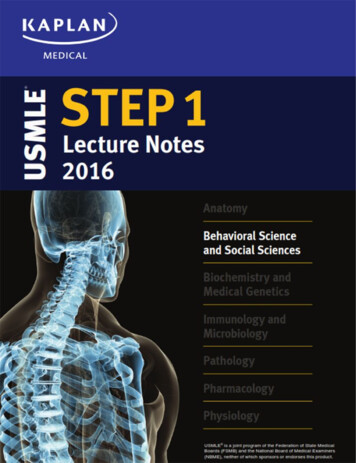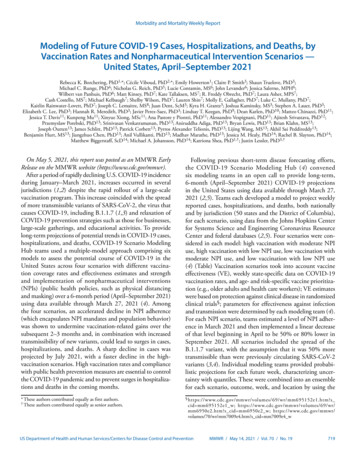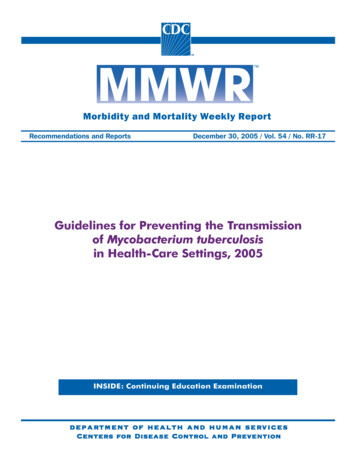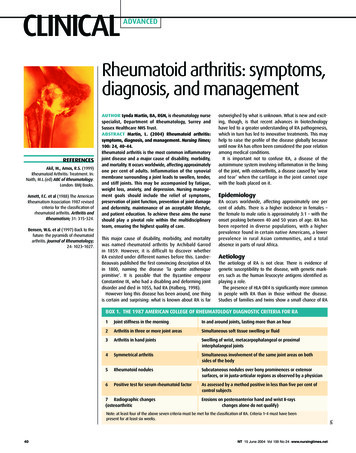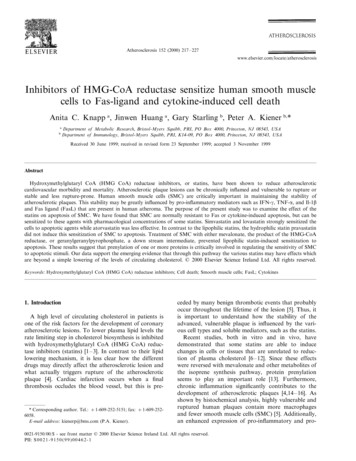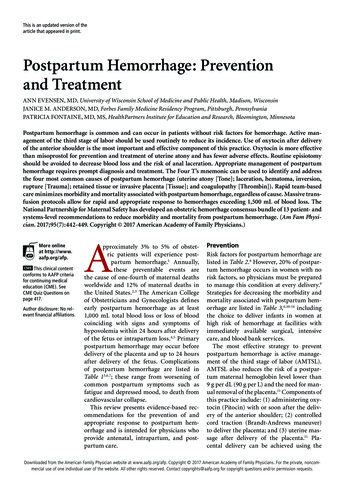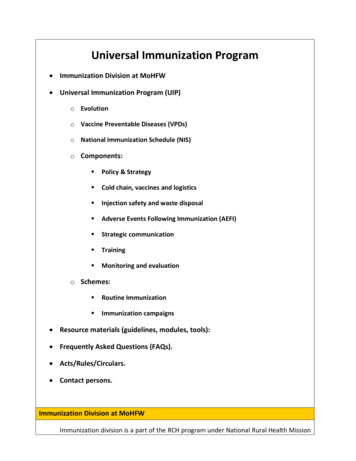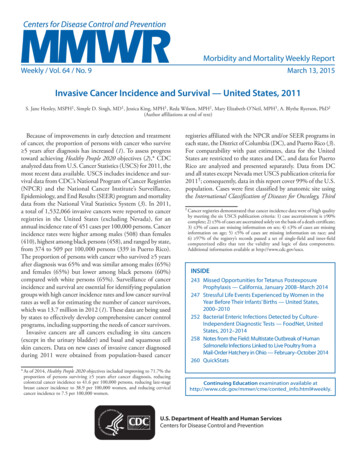
Transcription
Transforming the Morbidity and Mortality Conferenceinto an Instrument for Systemwide ImprovementJamie N. Deis, MD; Keegan M. Smith, MD; Michael D. Warren, MD;Patricia G. Throop, BSN, CPHQ; Gerald B. Hickson, MD; Barbara J. Joers, MHSA, CHE;Jayant K Deshpande, MD, MPHAbstractObjective: The morbidity and mortality conference (M&MC) is a traditional forum that providesclinicians with an opportunity to discuss medical error and adverse events. In an effort topromote patient safety at our institution, we implemented a monthly interdisciplinary morbidity,mortality, and improvement (MM&I) conference, which focused on systemwide problems. Theparticipants included physicians, nursing staff, pharmacy, and other clinical departments, as wellas senior hospital administrators. Methods: A Mortality Review Task Force selects cases forpresentation at the monthly MM&I. A resident representative presents the case, and a designatedsenior faculty member facilitates a discussion of the case with audience participation. Key issuesthat contributed to the undesired outcome of the case are identified and outlined on a cause-andeffect diagram (Ichikawa diagram). Workgroups are created to target systems-based problems.At the end of the conference, attendees are asked to complete an evaluation and provide feedbackfor subsequent consideration by the task force. Results: Twenty-one cases (12 medical, 9surgical) representing adverse events were presented at the MM&I conference from January2005 to February 2007. The mean number of participants per session was 88 (range, 62-115).Adverse events triggering case selection included unexpected deaths (six), unplanned intubations(two), prolonged medical care in the setting of poor prognosis (one), delay in care (nine), andprocedural complications (three). The most common factors contributing to adverse or “nearmiss” outcomes in these cases were communication failures and inadequate coordination of care.In all, 33 action items were created, and 23 (70 percent) have been completed to date.Conclusion: A structured hospital-wide MM&I conference is an effective means of engagingphysicians, nurses, and key administrative leaders in the discussion of adverse events. Theidentification of potential system failures and the creation of workgroups to address specificsystems-based problems can promote initiatives to improve patient care and safety.BackgroundIn order to provide high quality patient care, members of a multidisciplinary health care teammust engage in objective, nonjudgmental review of adverse outcomes and commit to systematicprocess change. The morbidity and mortality conference (M&MC) is one forum that providesclinicians with an opportunity to discuss medical error and adverse events. The M&MC becamea major part of physician education in the early 20th century, following the publication of theFlexner report on medical education in 1910 and the creation of the American College of1
Surgeons in 1912. 1, 2 These early conferences were attended primarily by surgeons andanesthesiologists and were used to examine medical errors and adverse outcomes in an attempt toimprove surgical practice.Over the years, the M&MC has evolved into a forum for resident education. The conference isnow a required component of surgical resident training, mandated by the Accreditation Councilfor Graduate Medical Education (ACGME), 3 and it is also widespread among internal medicineand pediatric training programs. Despite the extensive presence of the M&MC, the format of theconference varies tremendously among academic programs, and the goals of the conferenceoften are not clearly defined. 4 Many of the cases presented for discussion are selected because oftheir educational interest or potential teaching value and often lack identification and discussionof adverse outcomes. 5, 6, 7 Biddle reviewed cases presented at the anesthesia M&MC at hisinstitution and found that 72 percent involved neither morbidity nor mortality.6 In a crosssectional review of the medicine M&MC at four major hospitals in California, Pierluissi foundthat most of the allotted time was spent on case presentation and guest speaker commentary, withvery little audience participation or discussion of error.7When error is discussed in the M&MC, the focus is often on an unexpected adverse outcomeinstead of events related to processes of care that might have contributed to the error.5 Physiciantrainees attending the M&MC often feel that the purpose of the discussion is to assign blame foran error rather than to improve patient safety.5, 8 Systems-based issues are rarely identified, andoften there is not enough time to discuss specific interventions to improve patient care acrosssystems of care.In an effort to promote patient safety at our institution, we implemented a monthly hospital-widemorbidity, mortality, and improvement (MM&I) conference, which focused on systems-basedproblems at our hospital and included representation from multiple clinical departments, as wellas from senior hospital administrators. Here, we describe our first 2 years’ experience with theMM&I conference and discuss the lessons learned.Process and MethodologyThe Monroe Carell, Jr. Children’s Hospital at Vanderbilt (MCJCHV) is a 222-bed tertiary carechildren’s hospital that is part of a large academic medical center. The MM&I is part of ourformal peer review and quality improvement processes sponsored by the offices of PerformanceManagement and Improvement (PMI) and Risk Management.Case selection. A Mortality Review Task Force reviews potential cases and selects cases to bepresented at each conference. Eligible cases include all deaths, significant patient injuries, andnear-miss situations that could have resulted in death or patient harm. Any member of the healthcare team at any level or location in the institution can recommend specific cases to the MortalityReview Task Force. The referral remains anonymous in order to encourage submissions of casesthat might involve emotionally charged or difficult situations. Other sources of potential casesinclude departmental or unit-based M&MC and the office of Risk Management.The Task Force is composed of senior attending physicians and residents from pediatric surgeryand pediatric medicine, community pediatricians, hospital administrators, and leaders in nursing,pharmacy, and radiology. Two pediatric resident volunteers serve as conference coordinators2
each academic year. Rather than focusing on individual caregiver errors, the Task Force selectscases that potentially involve systemwide problems or issues that affect more than one patientcare population or single hospital unit. The case selection is made by consensus of the TaskForce.Case preparation and presentation. A core team—consisting of senior quality consultantsfrom PMI, the resident coordinators, and a senior attending facilitator—is responsible forpreparing the case for presentation. In the month preceding the MM&I conference, the core teammeets to gather and review pertinent documents from the patient’s hospitalization from the initialencounter until disposition from the hospital or clinic. In order to highlight specific systemsissues that might have contributed to the adverse event, the case details are then summarized in atime series flow diagram. This process generally requires two to three 60-minute meetings. Theresident coordinators also spend an additional 2 to 3 hours preparing a brief literature review ofthe disease or illness specific to the case.All clinical faculty and staff are invited to attend the conference. Health care providers involvedwith the case receive a special invitation to participate in the conference. In addition,subspecialists are invited to comment on specific aspects of the case. For example, pediatricradiologists are asked to review the appropriate imaging studies related to the case. Thepresentation is organized in slide format for presentation with Microsoft PowerPoint .Conference. Attendance at the MM&I is encouraged for all hospital physicians, residents,nursing staff, and clinical support staff, regardless of level of training or provider status. As partof the institution’s peer review and quality improvement processes, the MM&I discussion isconsidered privileged and confidential.Table 1 shows the conference outline. Every conference begins with a reminder of the systemsbased approach to identifying problems and the confidentiality of the discussion. One of thepediatric resident coordinators presents the patient’s management and hospital course in atimeline format. Appropriate data are reviewed, including vital signs measurements, nursingTable 1.Conference outlineMM&I conference outlineTime allottedParticipants Opening: Reminder of systems-based approach andconfidentiality5 minLeader Review of task force progress from prior conferences10 minMMI task force Case presentation (timeline format)10 minResident leaders Brief literature review relevant to case in question5 minResident leaders Identification of key issues leading to undesired outcome25 minAll participants Identification of workgroups to address the key issues10 minMMI task force Reminder of confidentiality5 minLeader Evaluation of conference5 minLeader3
assessments, laboratory and radiographic data, and physician physical examinations.Deidentified records from the patient’s chart are used throughout the presentation as appropriate.A computerized system (Turningpoint, Turning Tech, LLC) prompts the audience to considerwhich management decisions they would have made at key points in the patient’s clinical course.The system provides an immediate summary of their responses, encouraging further discussion.Throughout the discussion, a cause-and-effect diagram (Ichikawa diagram 9 ; Figure 1) is used toidentify specific factors that might have contributed to the adverse outcome in the case. Thecause-and-effect diagram is a standard process improvement tool for facilitating identification ofpotential failure points.These factors are assignedto one of six broadPeopleProcedureEquipmentcategories: (1) procedure,(2) environment,(3) equipment, (4) people,(5) policy, or (6) other. AllAdverseparticipants have anoutcomeopportunity to identifysystems-based issues andrecommend potentialsolutions. After these issuesEnvironmentPolicyOtherare identified, thediscussion leader selectsthe key contributing factorsFigure 1. Ichikawa (“fishbone”) cause-and-effect diagram.that need to be addressed.“Action plans” are created,and specific workgroups are assigned to implement the corrective actions. The action planidentifies a concise intervention, assigns accountability (including completion targettimeframes), and tracks the status of implementation. The Task Force is responsible for assistingthe workgroups in completing the assigned tasks, and the progress of each workgroup ispresented at subsequent conferences.As the conference is adjourned, the confidential nature of the proceedings is again reinforced.Attendees are asked to complete an evaluation and to provide feedback for subsequentconsideration by the Task Force. Evaluations consist of eight questions using a 5-point Likertscale, ranging from “Excellent” to “Poor,” with space available for free-text comments.Completion of the evaluations is voluntary and is done anonymously.MM&I ResultsTwenty-one cases representing adverse events were presented in the MM&I conference seriesbetween January 2005 and February 2007. Both medical (N 12) and surgical (N 9) caseswere represented. Adverse events triggering case selection are listed in Table 2. An unexpecteddeath, as identified through root cause analysis (RCA), was the most common reason for caseselection. At our hospital, the RCA process is multidisciplinary and interdisciplinary and drawson the expertise and clinical opinion of all participants. Other cases were selected based on4
undesirable outcomes nottypically addressed intraditional M&MCs, such asprolonged medical care withpoor prognosis.The presentations alsoincluded cases from multiplecare sites, including theemergency department,outpatient clinics, inpatientwards, and the operatingroom.Table 2.Adverse events triggeringcase presentationsCaseNUnexpected deaths6Unplanned intubation2Prolonged medical care in setting of poor prognosis1Delay in care or diagnosis9Procedural complication3Total21Conference participants identified the leading contributors to adverse or “near-miss” outcomes.These contributing factors were categorized by the core team and are summarized in Table 3.Inadequate or incomplete communication among members of the health care team was the mostcommon contributing factor, cited in over 60 percent of the cases.Attendance. In all, 1,323 participants attended 19 conferences during the 2 year period. Theaverage number of participants per session was 88 (range, 62-115). Attendees included facultyand resident physicians, community physicians, medical students, nurses, pharmacists, casemanagers, social workers, and senior hospital administrators.Impact of the conference. The MM&I conference represents an ongoing commitment of TheMonroe Carell, Jr. Children’s Hospital at Vanderbilt to improving patient care and safety. Duringthe 2-year period, 33 action items were created to address specific systems-based issues; 23action items (70 percent)Table 3.Factors contributing to adverse outcomehave been completed todate. The action plansFactor% Casesdeveloped in the MM&ICommunication:conferences and the64e.g., inadequate handoffs; incomplete clinicalsubsequent activities of theinformationworkgroup are among theCoordination of care:mechanisms by which36e.g., involving multiple services and/or care sitesprocess improvementoccurs.Volume of activity/workload:Example case and actionplan. In April 2005, theMM&I conference presenteda case in which apostoperative patientexperienced respiratoryfailure on the acute carefloor. Excerpts from thee.g., increased clinical volume and/or perception ofworkload18Escalation of care:e.g., delay or failure to involve more senior physicianor nurse14Recognition of change in clinical status:e.g., delay or failure to recognize changing clinicalsigns and/or symptoms145
patient’s medical record—including vital signs, nursing care notes, and physician’s progressnotes—were presented and demonstrated a continued decline in the patient’s clinical conditionthroughout the day, with increased respiratory rate, increased work of breathing, and persistenthypoxia, despite supplemental oxygen. The patient subsequently required emergency intubationand was resuscitated before being transferred to the critical care unit.After reviewing the available records, the MM&I conference attendees identified multiplecontributing factors. From an “environment” standpoint, attendees noted that the timing of thepatient’s deterioration occurred at nursing shift change, and that likely was a contributing factor.From a “people” standpoint, conference attendees also noted that there was a delay inrecognition of changing vitals signs by multiple members of the health care team. The attendeesidentified additional issues under “communication,” including incomplete exchange of keyclinical information (i.e., vital signs) between nursing staff and resident physicians andinadequate communication between multiple services involved in the patient’s care.Because of these concerns, an action plan was created to implement the SBAR communicationmodel within our hospital. SBAR (Situation, Background, Assessment, and Recommendation) 10is a structured communication technique that allows for concise but thorough communicationamong members of the health care team. The pediatric chief resident and a member of the PM&Ioffice were initially assigned to execute the implementation of SBAR. Ultimately, numerousstaff members contributed to this action plan, including members of hospital administration andnursing leaders. This action plan has led to hospital-wide implementation of SBAR as thestandard mode of communication among members of the health care team. The SBAR model hasbeen promoted during orientation for new residents and nurses and reinforced during residentdidactic conferences and subsequent MM&I conferences.LimitationsWhile the MM&I has led to several process improvements at our institution, these processchanges have not yet been rigorously evaluated to determine their effects on patient safety,morbidity, and mortality. Our current study is largely a qualitative study that focuses on theMM&I process at our institution. Future research is needed to provide quantitative data on theimpact of MM&I-based initiatives. Another limitation of our current study is the low percentageof evaluations completed by conference attendees. While these evaluations provided valuablefeedback to the Task Force, the paper forms were completed by only 28 percent of attendeesduring the first 2 years of the MM&I. In order to elicit more feedback from conference attendees,a new approach to the evaluation process was initiated in May 2007. Conference attendees nowutilize the audience response system (Turningpoint, Turning Tech, LLC) to evaluate theconference before the conference is adjourned. This new strategy has resulted in a dramaticincrease in the number of evaluations completed by attendees.ConclusionThe structured hospital-wide MM&I conference is an effective way to engage multiple membersof the health care team in a discussion of adverse outcomes, while collaboratively focusing onpotential systems-based improvements in patient care and safety. Nonjudgmental case discussion6
helps overcome the individual’s fear of accusation and criticism, which can stifle honestexchange of information and hinder improvement initiatives. Identification of potential systemfailures by participants, empowerment of workgroups to address specific systems-basedproblems, and transparent accountability for regular followup can lead to improved patientsafety.AcknowledgmentsWe recognize Sandra H. Bledsoe, RN, ARM , Executive Director of Risk and InsuranceManagement, along with the Vanderbilt University Office of Risk and Insurance Managementfor their ongoing contributions and support.Author AffiliationsVanderbilt University Medical Center, Department of Emergency Medicine (Dr. Deis),Department of Pediatrics (Dr. Smith, Dr. Warren, Dr. Deshpande), The Monroe Carell Jr.Children’s Hospital at Vanderbilt (Ms. Throop, Ms. Joers, Dr. Deshpande), Center for Patientand Professional Advocacy (Dr. Hickson); Department of Anesthesiology (Dr. Deshpande).Address correspondence to: Jayant K. Deshpande, MD, MPH, Professor of Anesthesiology andPediatrics, Monroe Carell, Jr. Children’s Hospital at Vanderbilt, Vanderbilt University MedicalCenter, Department of Anesthesiology, Suite 5121 DOT, 2200 Children's Way, Nashville, TN37232-9075; telephone: 615-936-1302; fax: 615.936.3467; oceedings of conference on hospital standardization.Joint session of committee on standards. Bull Am CollSurg 1917; 3: 1.2.Flexner A. Medical education in the United States andCanada. From the Carnegie Foundation for theAdvancement of Teaching, Bulletin Number Four,1910. Bull World Health Organ 2002; 80(7): 594-602.Epub 2002 Jul 30.3.4.ACGME Program Requirements for Graduate MedicalEducation in Surgery. Chicago, IL: AccreditationCouncil for Graduate Medical Education; 2008.Available at:http://www.acgme.org/acWebsite/downloads/RRC progReq/440 general surgery 01012008.pdf. AccessedJune 3, 2008.5.Hamby LS. Using prospective outcomes data toimprove morbidity and mortality conferences. CurrSurg 2000; 57: 384-388.6.Biddle C. Investigating the nature of the morbidity andmortality conference. Acad Med 1990; 65: 420.7.Pierluissi E. Discussion of medical errors in morbidityand mortality conferences. JAMA 2003; 290: 28382842.8.Harbison SP, Regehr G. Faculty and resident opinionsregarding the role of morbidity and mortalityconference. Am J Surg 1999; 177: 136-139.9.Plsek PE, Onnias A. Cause-effect diagrams. Qualityimprovement tools, second ed. Wilton, CT: JuranInstitute, Inc; 1994.10. Haig KM, Sutton S, Whillington J. SBAR: A sharedmental model for improving communication betweenclinicians Jt Comm J Qual Pat Saf 2006; 32: 167-175.Orlander JD. The morbidity and mortality conference:The delicate nature of learning from error. Acad Med2002; 77: 1001-1006.7
and it is also widespread among internal medicine and pediatric training programs. Despite the extensive presence of the M&MC, the format of the conference varies tremendously among academic programs, and the goals of the conference often are not clearly defined. 4. Many of t

